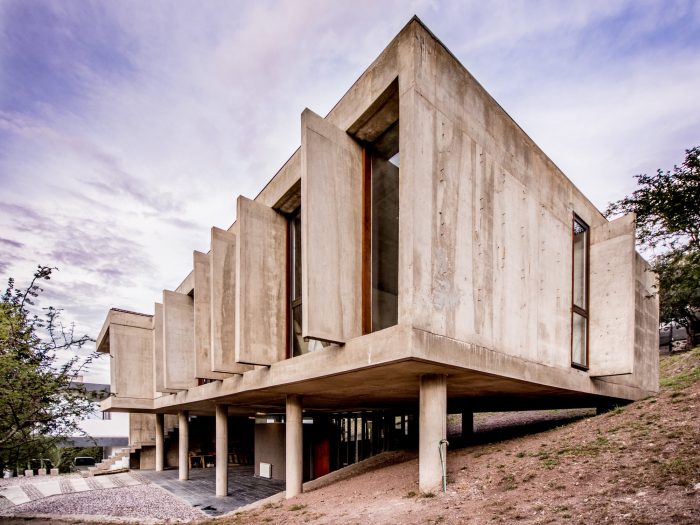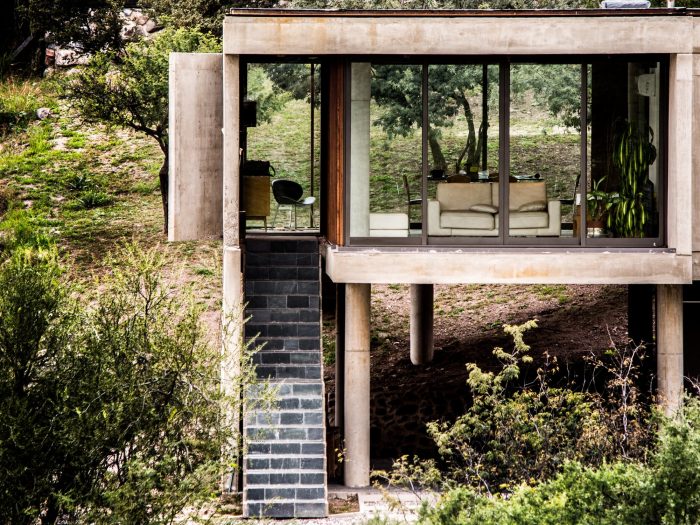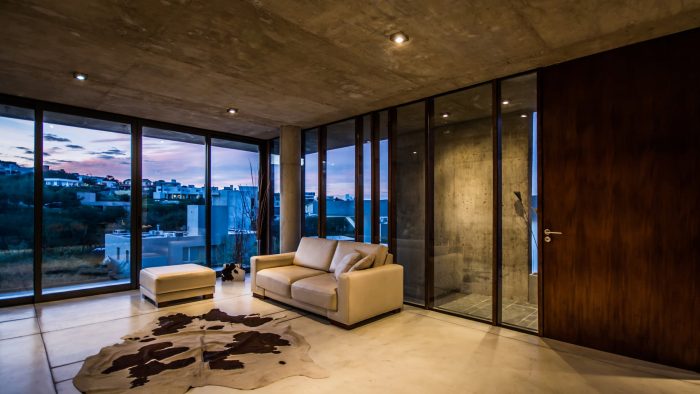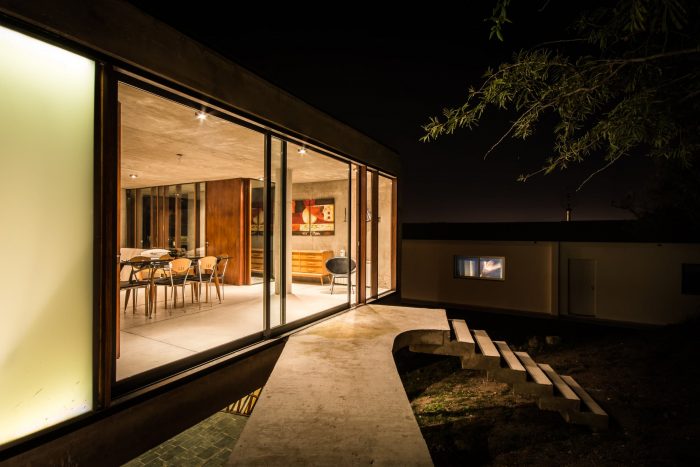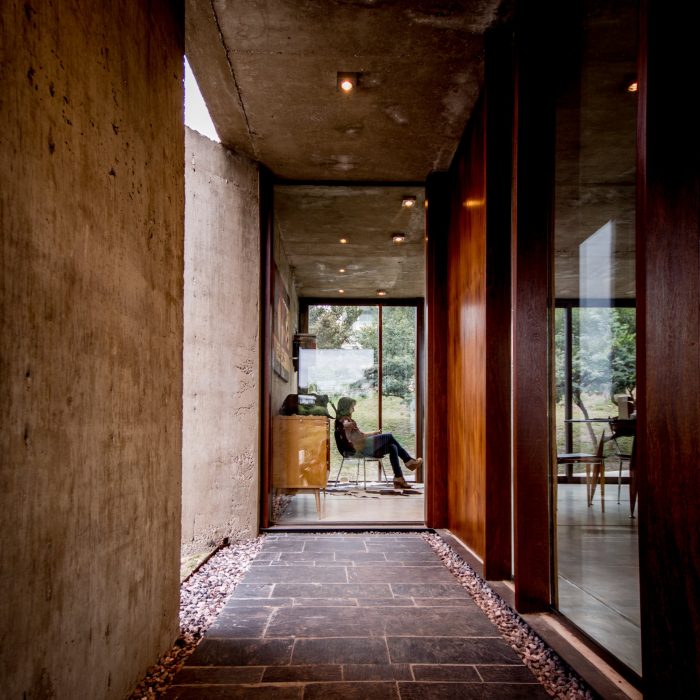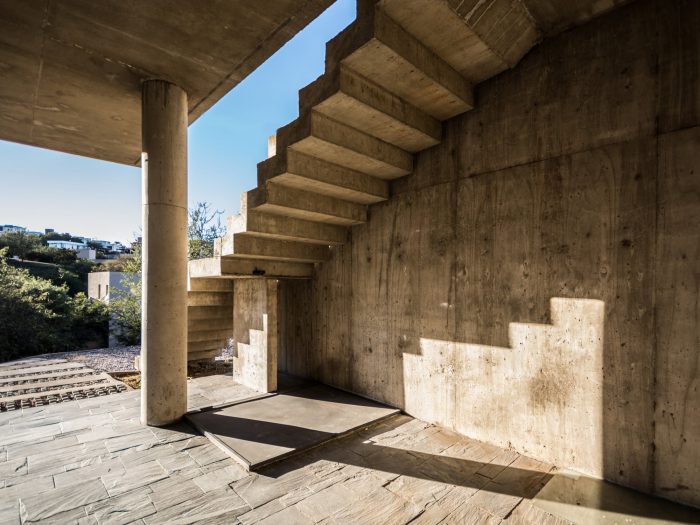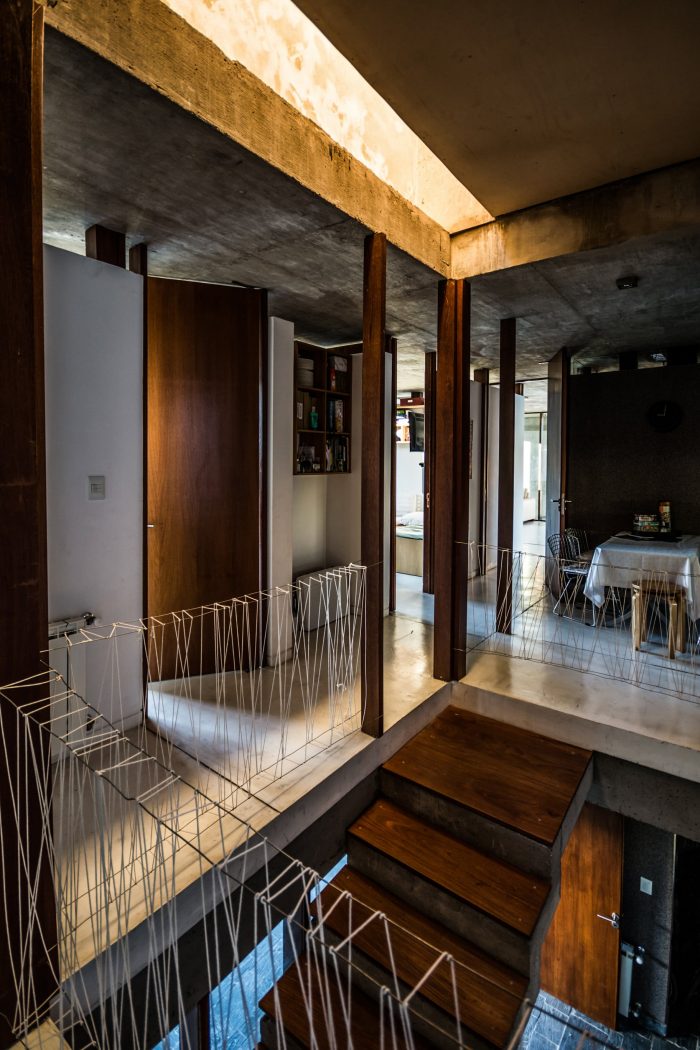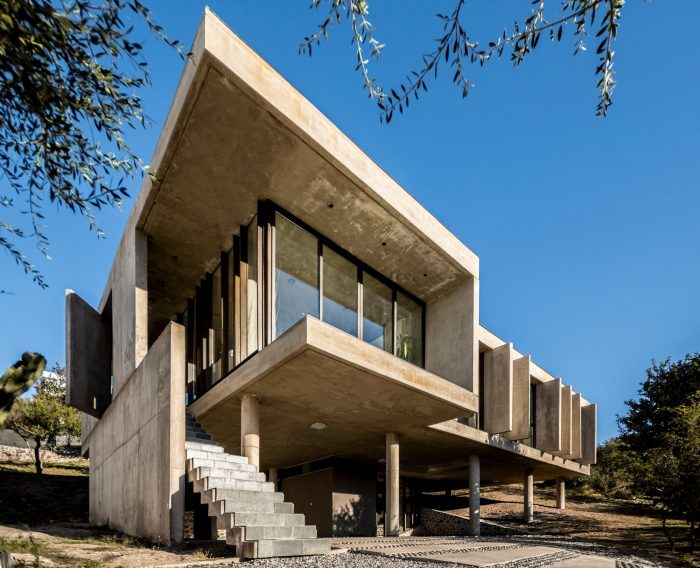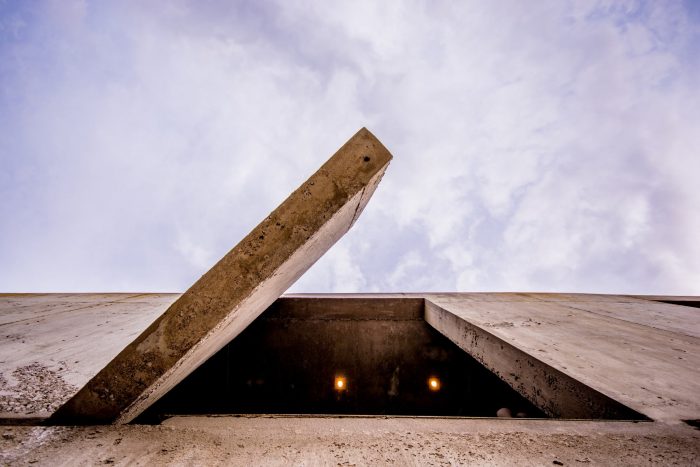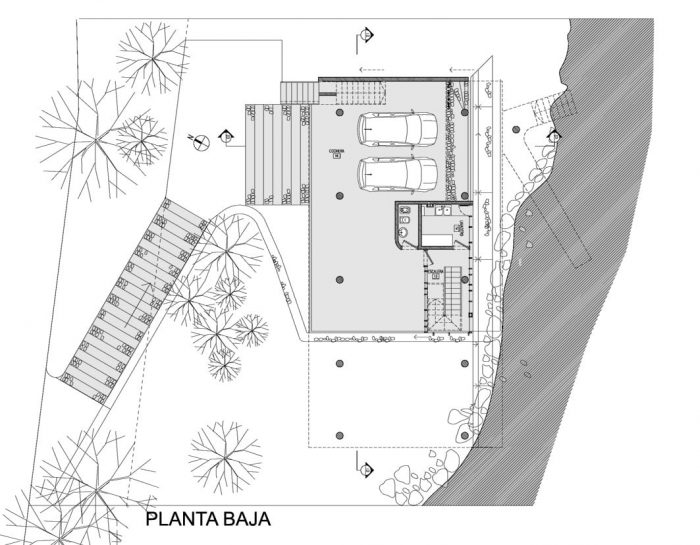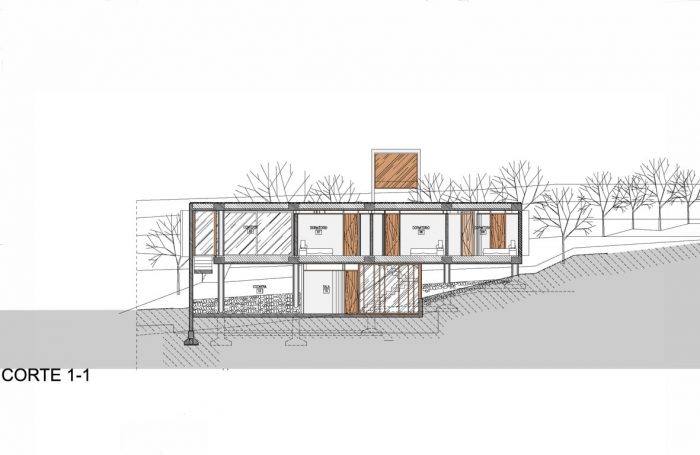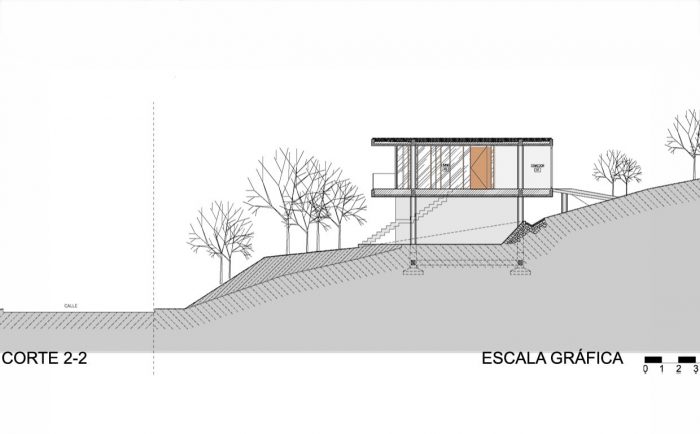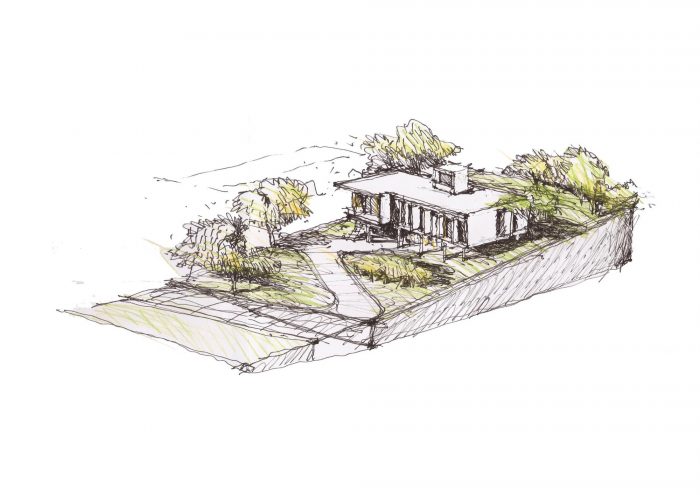该项目是在1100平方米的土地上开发的,位于La Calera地区。它坐落在一个山丘上,可以看到附近的一个适当的山谷,朝向西北,前后之间的坡度为15米。
The project is developed in an 1100 m2 plot, located at the locality of La Calera. It is inserted on a hill that looks to a proper valley of the neighborhood, with a northwest orientation and a grade of 15 meters between the front and back.
该地区的特点是陡峭的斜坡。这就是为什么第一个想法是寻找一个策略,允许一个平坦的空间来放置房子。这涉及到一个明显的智能操作,包括挖出地块后面的山,并补充到前面,获得有价值的平面来支撑建筑。这个解决方案,在大多数情况下使用,一方面,由于挖掘,对自然地形造成了严重的破坏,另一方面,后院看起来像一个 “被咬 “的山。
The neighborhood is characterised by its steep slope. That’s why the first idea was to look for a strategy that allowed a flat space to place the house. This involved an apparently intelligent operation, which consisted in digging out the mountain at the back of the lot, and with that replenishing the front, acquiring the valued flat plane to hold up the architecture. This solution, used in most of the cases, generated on one hand, an important damage to the natural topography because of the excavation, and in the other hand, backyards that looked to a “bitten” mountain.
在与造成这种干预的损害不一致的情况下,我们呼吁勒-柯布西耶的想法,即把整个体积提升到地形上,让山在下面运行,通过两块板,”屋顶和地板 “的表现,人为地获得平坦的必要空间,两者都由混凝土柱支撑。
In discordance with the damage that caused this intervention, we appeal to Le Corbusier’s idea of lifting the whole volume across the topography, letting the mountain run beneath, obtaining the flat necessary space, artificially, through the performance of two slabs, “roof and floor”, both supported by concrete columns.
背景的地形运动,由于其强烈的衔接性,产生了各种不同的视角。一个有趣的例子是,当我们从街面看到房子的时候,随着视角的影响,房子地板下的坡度开始变平,通过透明玻璃可以看到绿色的垂直包络。
The topography movements of the context, generates a variety of perspectives because of the strong articulation of it. An interesting example of this is when we see the house from the street front, where the slope that goes under the floor of the house begins to flatten as the perspective effects and it is seen as green vertical envelopes through the transparencies.
这个方案与山体产生了一种更加综合和尊重的关系,在地点和建筑体量之间建立了真正的对话。这一点非常重要,因为 “建筑在地形中的插入 “是该办公室最关注的问题之一。
This option generated a more integrated and respectful relation with the mountain, establishing a true dialogue between the location and the architectural volume. This is really important, because “the building’s insertion in the terrain” is one of the biggest concerns of the office.
建筑体量是一个悬空的矩形,让下面的区域作为车库、洗衣房和半遮盖的空间。入口被解决在左侧,在高贵的平面上,通过一个楼梯和一个小的半遮盖的入口大厅,从那里你可以进入餐厅。房间被安排在前面,使用最好的方向和视觉效果。厨房、浴室和梳妆台被安排在后面。
The architectural volume is a suspended rectangle, that lets the area beneath be diligent as a garage, laundry and semi-covered space. The entrance was resolved on the left side, upon the noble plane, throughout a stair with a little semi-covered entrance hall, from where you accede to the dining room. The rooms were organized towards the front, using the best orientations and visuals. The kitchen, bathrooms and dresser were disposed at the back.
所有的外墙都是用混凝土建造的,并配有符合阳伞的围栏。在夏天,当西面被旋转到正面时,它们产生了一系列连续的阴影,减少了太阳辐射,使大面积的玻璃可以工作。房子的后部,如厨房,涂有5+5的乳白色pvb玻璃板,作为一个半透明的围墙继续穿过浴室。
All of the facades were proposed in concrete, with gathers that conform parasols. During the summer, when the west is rotated to the front facade, they generate a series of successive shadows that reduce the solar radiation, making workable the big superficies of glass. The rear face of the house, as the kitchen, is coated with sheet glass 5+5 with opaline pvb that continues through the bathrooms as a translucent enclosure.
房子的内部解决了极度质朴的混凝土和内部完美的白墙之间的矛盾的想法,它从白色的微水泥地板升起,它没有达到板块的分离,只是足以在两种材料之间产生张力,功能上解决了玻璃窗。
The interior of the house is resolved with the idea of contraposition between the extremely rustic concrete and the perfectly white walls of the inside, that rise from a white floor of micro cement, which doesn’t reach the slab separated just enough to generate tension between the two materials, functionally resolved glazed sashes.
在建筑师塞萨尔-纳塞利(Cesar Naselli)的教导下,插入是解决项目中的一个重要问题,光线进入建筑内部的方式,使空间升华为特殊的气候,并根据时间和季节而变化。这是通过位于楼梯上的木质涂层来实现的,上面反映了温暖的光量内的光染色。
As well as the insertion is an important matter to resolve in the projects, after the teachings from the architect Cesar Naselli, the way in which the light enters to the interior of the buildings, sublimating the spaces with special climate and changing according to hours and seasons. This was achieved through a wood coating located on the staircase, on which reflects light staining inside a warm light volume.
构成房屋结构的十根柱子被放置在一个倒梁的纬线上,能够支撑起小块的实心板,使它们的下半部分看起来像一个纯粹的混凝土体积。梁的配置产生了连续的缝隙,用发泡胶填充,解决了由于与外部接触的 “飞行 “地板而产生的劣质的隔热问题。
The ten columns that conform the structure of the house are disposed conforming a weft of inverted beams, capable of sustaining little solid slabs, making the inferior part of the them look as a pure concrete volume. The beams disposition generated successive gaps that are filled with styrofoam, solving the inferior thermal insulation problem produced because of the “flying” floor in contact with the exterior.
Architects: Daniella Beviglia, Santiago Carlos Viale
Area : 316 m²
Year : 2013
Photographs :Gonzalo Viramonte
Team : Ana Laura Aquilante, Sofia Ariño, Sebastían Mantese, Damian Durando, Martín Mora, Gabriela kozameh, Julieta Astorica, Paula Ducant
Structure Calculation : Germán Sarboraria
A/C : Ingeniería Global
City : Córdoba
Country : Argentina


